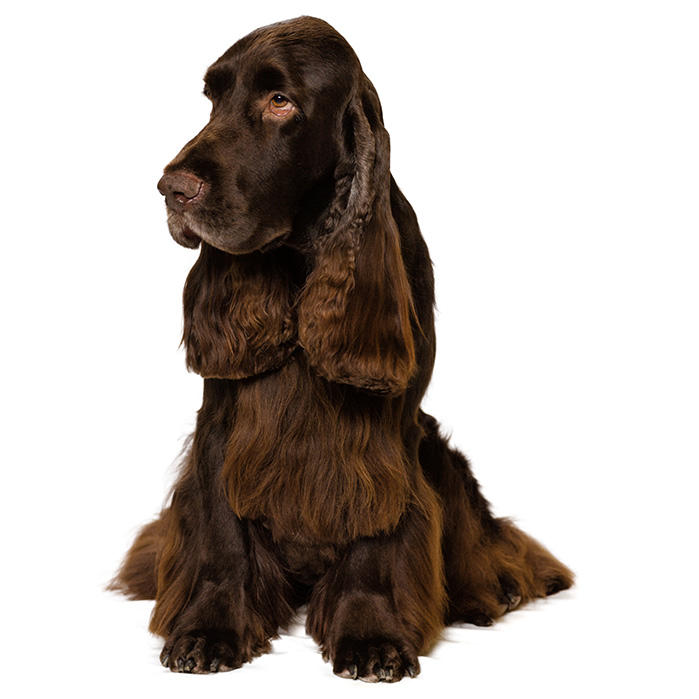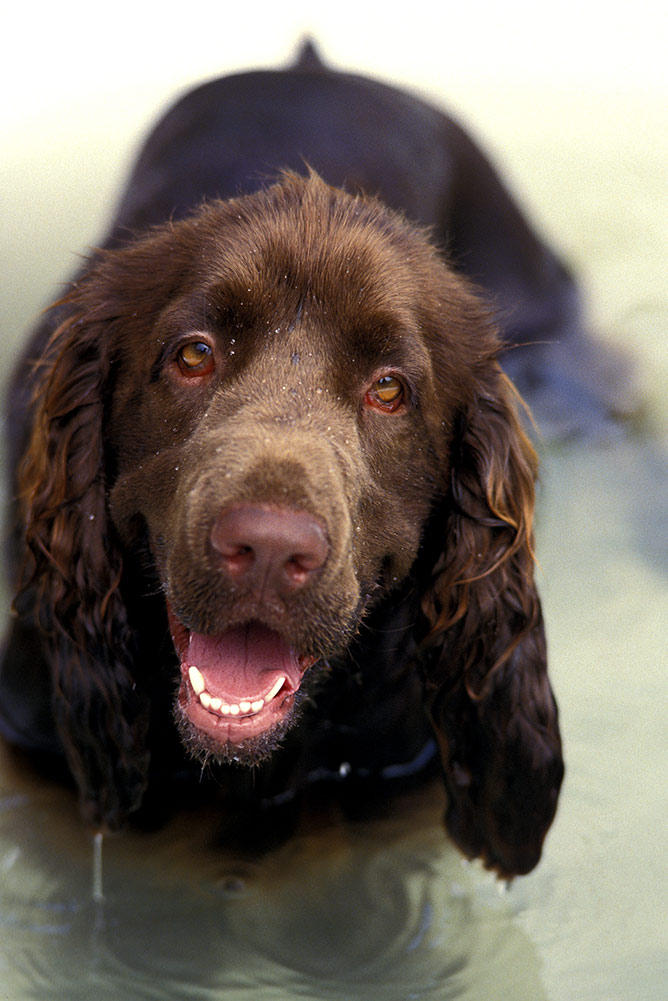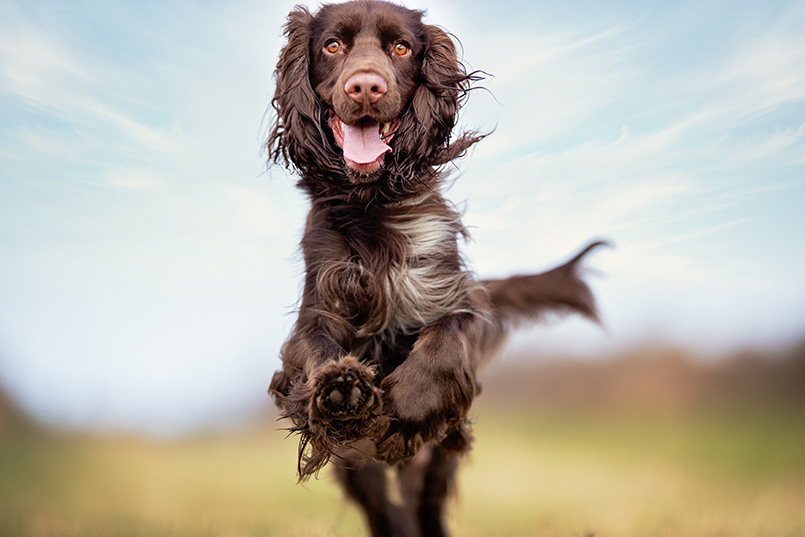Field Spaniel
Sweet, sensitive, fun-loving, independent
This breed has a medium probability of having health issues in its lifetime, hence it is one of the more affordable breeds to insure.

Is this breed right for you?
Try our breed selector quiz to find out your best matching breed!
Insuring a Field Spaniel?
Get our award-winning Nose-to-Tail Cover with up to $30k annual benefit limit, up to 90% of eligible vet bills back, and no sub-limits.
Get a quick quoteBreed Overview
The Field Spaniel is a medium-sized sporting dog breed of Spaniel type. She is a hunting companion bred for activity and endurance in a heavy cover and water who will work enthusiastically in the field – hence her name. Solidly built, with moderate bone and firm, smooth muscles, she is sturdy and athletic. She reaches a height of approximately 46 cm at the shoulders and a weight of 18 to 25 kg.
Affectionately called the ‘Field’, she bears a familial resemblance to Cocker, Springer, and Sussex Spaniels. She has a well-balanced, upright carriage, a docile and unassuming attitude and a serious, gentle and intelligent expression. Her attractive, glossy coat is moderately long and comprises a single layer. It comes in solid colours of black and liver, or in combinations of the two. Feathering of the fur appears on the chest, belly, ears and on the back of the legs. Her long, feathery ears frame her expressive face.
She is active and inquisitive and makes a good companion who enjoys brisk activity as well as downtime at home with her family. It is essential that she gets regular exercise and mental stimulation; if left alone and unoccupied for long periods of time, she may become bored, hyperactive and destructive. The show ring, canine sports such as agility, and of course, hunting, are all arenas where she can find the physical and mental challenges she needs.
Fields are found in a wide variety of lifestyles, from city to country, but are particularly well suited to country dwelling. However, they are not everyone’s cup of tea, having some unattractive traits such as snoring, sloppy drinking and perpetually shedding coats.

Personality and Temperament
The Field Spaniel loves people and is a loyal, affectionate companion who is devoted to her family and likes to stay close to them. The breed is known for its calm, sweet and sensitive nature and is not as excitable as its close relative, the Cocker Spaniel – in fact, the U.S. breed standard describes the Field as “unusually docile”.
In attitude, the Field can range from serious to fun-loving to clownish. She is inclined to be reserved with strangers but will gradually warm up to them. She is patient and trustworthy with children. Despite their docility, Fields are unusually active and very independent. They are also known for their level-headedness and perseverance. With their deeply rooted hunting drive and tracking ability, they are energetic and enthusiastic whether at play or working in the field. They are playful and enjoy a good backyard romp.
Fields are receptive to training and can be motivated by their desire for food. They are intelligent problem-solvers who can excel at most tasks when properly motivated. They are “thinking dogs” who need to understand what is expected of them and thrive on clear communication and reward, with minimal correction. They require early socialisation and a trainer who is sensitive to their needs. When socialised, they are good with other dogs and tolerant of other animals.
Common Field Spaniel Diseases & Conditions
Symptoms, diagnosis and treatment
A generally healthy breed, the most common health issues affecting Field Spaniels are hip dysplasia and hypothyroidism. Less common are eye problems, heart disease and epilepsy.
- Hip dysplasia: Hip dysplasia is a genetic condition with possible environmental contributors, such as feeding practices and exercise. In this condition, the hip joint does not develop properly, allowing the hip to partially dislocate. It is the most common cause of osteoarthritis of the hip in dogs.
- Hypothyroidism: Low thyroid function occurs when the thyroid gland does not produce enough hormones. It is a fairly common condition in Field Spaniels that can lead to sparse coat growth, skin infections and weight gain, among other problems. Putting affected dogs on thyroid medication regulates the condition.
- Eye conditions: The most common eye conditions occurring in Field Spaniels are folds in the retina, ectropion and entropion. Retinal Folds are small folds that occur within the tissue of the retina that usually disappear by the end of the puppy’s first year; the cause is currently unknown, but the consequences to vision do not appear to be serious. Ectropion, or saggy eyelids, and entropion, eyelids rolling in, are inherited. A dog with saggy eyelids may be more prone to infection from foreign objects in the eye. Eyelids rolling in—much rarer in Field Spaniels—may cause scratches to the cornea which could damage vision over time.
- Heart conditions: Heart conditions may be genetic (inherited), congenital (present from birth), or acquired (develop as the dog ages). Signs of heart disease in dogs can vary, depending on the type and severity; sometimes there may be no symptoms at all.
- Epilepsy: Epilepsy is a neurological disorder that is characterised by recurrent, unprovoked seizures. Seizures can have many causes including genetic problems, tumours, high fever and ingestion of a toxic substance. Breeders and owners of Field Spaniels have reported seeing late-onset epilepsy in dogs seven to over ten years old with no prior history of seizures.
Not all conditions are covered by Pet Insurance. For details of Bow Wow Meow Pet Insurance cover, refer to the Product Disclosure Statement.

History
The earliest Spaniels originated in Spain, which explains their name, but most of the modern breeds were developed in Britain. Well into the 1800s, the several British Spaniels used by hunters for flushing gamebirds from cover were not classified by breed, as they are today. Rather, they were organized by size and job description – the larger Spaniels were called Springers, and the smaller ones Cockers, named after the woodcocks they excelled in flushing.
With the onset of dog shows in England in the 1870’s, categorising specific types and breeds became important, and the name Field Spaniel was used to describe the Spaniel type born of Cocker, English Springer and Sussex crosses. Already skilful hunters, these early Fields found immediate success in the show ring.
Field Spaniels were one of the first breeds to be shown and registered in America. Their show careers trace back to the early 1880’s with records showing that a black Field Spaniel was an American Champion by 1883, a year before the American Kennel Club was founded.
Unfortunately, the Field’s accomplishments in the arena encouraged breeders to produce a showy Field Spaniel, with an extremely long, low shape that was described as a “grotesque caricature of a spaniel”. These short-sighted breeding practices destroyed the Field’s value as a gundog and introduced health problems to the breed. The Field’s decline was as rapid as its ascent, the breed soon teetered on the brink of extinction.
During the mid-20th century the Field was resurrected by dedicated breeders who re-introduced Cocker and Springer blood, rebuilding the dog along its original lines as a longer-legged dog that was once again suitable to be used for field work, retrieving game from land or water. In the decades since, the Field Spaniel’s rise and fall and rise-again has served as a cautionary tale for dog breeders.
Nowadays, the breed has evolved into one that is fit for both the show ring and the home, with no difference between working dogs and show bred dogs, and it is the mission of Field Spaniel Societies around the world for the breed to remain as such. While she retains her excellent hunting skills, the Field is mainly a family companion and show dog and is rarely seen in the field.

Field Spaniel Facts!
- Like other Spaniels, the Field Spaniel is classified as a sporting dog (gundog), developed to work in the field with hunters to locate and retrieve quarry.
- The first Field Spaniel registered in America was named “Dash,” born in 1879, and imported by Mr. A. H. Moore.
- Field Spaniels adore their meals and treats and are sometimes jokingly referred to as “Food Spaniels”.
- The breed was once on the brink of extinction due to breeding fads of the era.
- As a rare breed, most Fields are fairly closely related.
Free engraved pet ID tag on sign up3
Customer Satisfaction
21 day cooling off
Easy to use Pet Portal

GapOnly® in vet claims
FURTHER INFORMATION
American Kennel Club – https://www.akc.org/dog-breeds/field-spaniel/
Field Spaniel Society of America – https://www.fieldspanielsocietyofamerica.org/
Dogs NSW – https://www.dogsnsw.org.au/Breeds/browse-all-breeds/13/Field-Spaniel/




